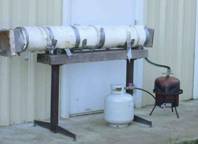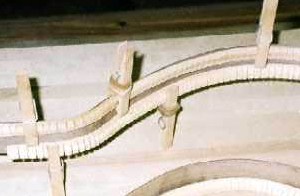Steaming:
To steam curve wood, you place the piece of wood to be steamed in a steam box. There are hundreds of designs for homemade steam boxes. The most common is to use a piece of PVC piece connected by a hose to a kettle or other container which is heated, as shown in Figure 3. The steam enters the box and heats and saturates the piece of wood with water.

Figure 3 - PVC steam box
The time that the wood should spend in the steamer will depend on its thickness and the species of wood. It will vary from 15 minutes to 1 hour per 1 inch thickness of the wood.
Once the wood is saturated, the piece of wood is removed and quickly placed in the jig that will create the curve.
The advantage to steam bending is that you end up with a solid piece of curved wood that will match any other adjacent pieces of wood.
The disadvantages to steam bending is having to construct the steam box, dealing with very hot materials that can easily scald the operator and spring back. A piece of wood that is curved using steam will spring back slightly after it is released from the jig.
Practice is very important when using steam bending. How long to leave the piece of wood in the steam box and how to compensate for the spring back can only be learned by trial and error.
Note: Always wear heavy gloves, to protect yourself from burns, when removing the wood from the steam box and placing it in the jig.
Note: The steam box that you construct should suit the size of the wood you wish to apply the curve to. There must be clearance around the piece of wood to allow the steam to access all points. However a steam box that is to big will require that the wood be in the steam box for a longer period of time than is necessary which wastes time and energy.
Microwaving:
Small pieces of wood can be curved by using a microwave as the source of heat and moisture. Wrap the piece of wood that you want to be curved in damp paper towel. Microwave on high for 10 to 20 seconds, remove from the microwave and quickly place it in the jig.
The exact amount of time required in the microwave will vary dramatically depending on the wattage of the microwave and the species of wood.
In the same manner as steaming, using a microwave will require trial and error to bring the wood to the correct temperature and moisture level.
Note: Always wear heavy gloves, to protect yourself from burns, when removing the wood from the microwave and placing it in the jig.
Notch Bending:
Using notches or kerf cuts in the wood is another method of bending a piece of wood, as shown in Figure 4.

Figure 4 - Notched lumber aids in creating curves
Cut notches in the piece of wood to be bent or curved 2/3 of the way through the piece of wood. The notches are usually the thickness of the saw blade and are spaced a saw blade distance apart from one another.
The disadvantage to this method is that the cut side of the lumber does not have visual appeal and if it is open to view it must be covered with a veneer of some sort. As well, pieces of wood are known to break even with the notches cut in them.
This method works well for items such as applying molding to curved walls, where the curve is gradual.
Note: Notched wood must be permanently held in its curved position with fasteners. It will not maintain its shape if left unfastened.
Note: In all cases it is the jig that will hold the piece of wood in its desired position until either the glue or adhesive dries or the wood dries that will determine the overall success or failure of the project.
Note: To avoid severe physical injury and/or divorce always obtain consent from your wife before using the microwave to heat wood and before using the kitchen kettle to build a steam box.
